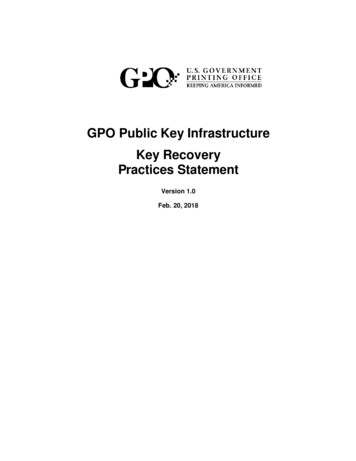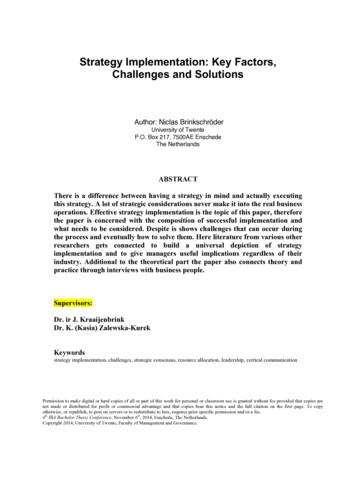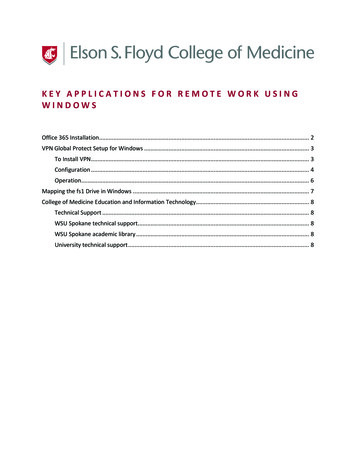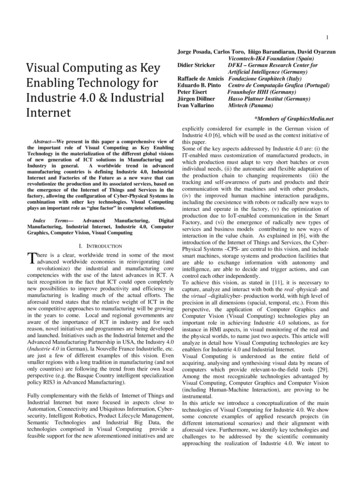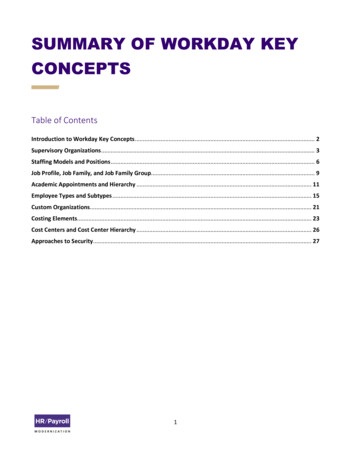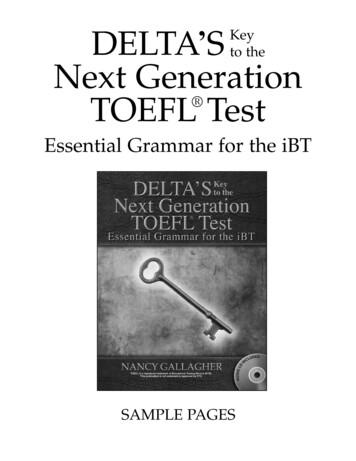
Transcription
Keyto theDELTA’SNext Generation TOEFL TestEssential Grammar for the iBTSAMPLE PAGES
ContentsAbout this Book . . . . . . . . . . . . . . . . . . . . . . . . . . . . . . . . . . . . . . . . . . . . . . . . . . . . . . . . . . . . . . . . . . . . . . . . 1About the toeFL . . . . . . . . . . . . . . . . . . . . . . . . . . . . . . . . . . . . . . . . . . . . . . . . . . . . . . . . . . . . . . . . . . . . . 3Diagnostic test . . . . . . . . . . . . . . . . . . . . . . . . . . . . . . . . . . . . . . . . . . . . . . . . . . . . . . . . . . . . . . . . . . . . . . . . 4Unit 1nouns. . . . . . . . . . . . . . . . . . . . . . . . . . . . . . . . . . . . . . . . . . . . . . . . . . . . . . . . . . . . . . . . . . . . . . . 7Unit 2Verbs . . . . . . . . . . . . . . . . . . . . . . . . . . . . . . . . . . . . . . . . . . . . . . . . . . . . . . . . . . . . . . . . . . . . . . 21Unit 3Infinitives and Gerunds . . . . . . . . . . . . . . . . . . . . . . . . . . . . . . . . . . . . . . . . . . . . . . . . . . . . . . . 41Quiz 1Units 1–3 . . . . . . . . . . . . . . . . . . . . . . . . . . . . . . . . . . . . . . . . . . . . . . . . . . . . . . . . 53Unit 4Clauses and sentences . . . . . . . . . . . . . . . . . . . . . . . . . . . . . . . . . . . . . . . . . . . . . . . . . . . . . . 54Unit 5Conjunctions . . . . . . . . . . . . . . . . . . . . . . . . . . . . . . . . . . . . . . . . . . . . . . . . . . . . . . . . . . . . . . . 64Unit 6Adverb Clauses . . . . . . . . . . . . . . . . . . . . . . . . . . . . . . . . . . . . . . . . . . . . . . . . . . . . . . . . . . . . . 76Quiz 2Units 4–6 . . . . . . . . . . . . . . . . . . . . . . . . . . . . . . . . . . . . . . . . . . . . . . . . . . . . . . . 89Unit 7Adjective Clauses . . . . . . . . . . . . . . . . . . . . . . . . . . . . . . . . . . . . . . . . . . . . . . . . . . . . . . . . . . . 90Unit 8noun Clauses . . . . . . . . . . . . . . . . . . . . . . . . . . . . . . . . . . . . . . . . . . . . . . . . . . . . . . . . . . . . . . 106Unit 9Conditional sentences . . . . . . . . . . . . . . . . . . . . . . . . . . . . . . . . . . . . . . . . . . . . . . . . . . . . . . . 115Quiz 3Units 7–9 . . . . . . . . . . . . . . . . . . . . . . . . . . . . . . . . . . . . . . . . . . . . . . . . . . . . . . . 128Unit 10singular and Plural . . . . . . . . . . . . . . . . . . . . . . . . . . . . . . . . . . . . . . . . . . . . . . . . . . . . . . . . . 129Unit 11Articles . . . . . . . . . . . . . . . . . . . . . . . . . . . . . . . . . . . . . . . . . . . . . . . . . . . . . . . . . . . . . . . . . . . 139Unit 12subject–Verb Agreement . . . . . . . . . . . . . . . . . . . . . . . . . . . . . . . . . . . . . . . . . . . . . . . . . . . . 148Unit 13Pronoun Agreement . . . . . . . . . . . . . . . . . . . . . . . . . . . . . . . . . . . . . . . . . . . . . . . . . . . . . . . . 160Quiz 4Units 10–13. . . . . . . . . . . . . . . . . . . . . . . . . . . . . . . . . . . . . . . . . . . . . . . . . . . . . . 175Unit 14Comparison. . . . . . . . . . . . . . . . . . . . . . . . . . . . . . . . . . . . . . . . . . . . . . . . . . . . . . . . . . . . . . . . 176Unit 15Prepositions . . . . . . . . . . . . . . . . . . . . . . . . . . . . . . . . . . . . . . . . . . . . . . . . . . . . . . . . . . . . . . . 187Unit 16Word order . . . . . . . . . . . . . . . . . . . . . . . . . . . . . . . . . . . . . . . . . . . . . . . . . . . . . . . . . . . . . . . . 198Unit 17Parallel structure . . . . . . . . . . . . . . . . . . . . . . . . . . . . . . . . . . . . . . . . . . . . . . . . . . . . . . . . . . 210Quiz 5Units 14–17 . . . . . . . . . . . . . . . . . . . . . . . . . . . . . . . . . . . . . . . . . . . . . . . . . . . . . . 218Unit 18Word Form . . . . . . . . . . . . . . . . . . . . . . . . . . . . . . . . . . . . . . . . . . . . . . . . . . . . . . . . . . . . . . . . 219Unit 19Common Word errors. . . . . . . . . . . . . . . . . . . . . . . . . . . . . . . . . . . . . . . . . . . . . . . . . . . . . . . 228Unit 20Punctuation . . . . . . . . . . . . . . . . . . . . . . . . . . . . . . . . . . . . . . . . . . . . . . . . . . . . . . . . . . . . . . . 237Quiz 6Units 18–20 . . . . . . . . . . . . . . . . . . . . . . . . . . . . . . . . . . . . . . . . . . . . . . . . . . . . 248Review test . . . . . . . . . . . . . . . . . . . . . . . . . . . . . . . . . . . . . . . . . . . . . . . . . . . . . . . . . . . . . . . . . . . . . . . . . 249Answer Key . . . . . . . . . . . . . . . . . . . . . . . . . . . . . . . . . . . . . . . . . . . . . . . . . . . . . . . . . . . . . . . . . . . . . . . . . 252Audio scripts. . . . . . . . . . . . . . . . . . . . . . . . . . . . . . . . . . . . . . . . . . . . . . . . . . . . . . . . . . . . . . . . . . . . . . . . 275Index. . . . . . . . . . . . . . . . . . . . . . . . . . . . . . . . . . . . . . . . . . . . . . . . . . . . . . . . . . . . . . . . . . . . . . . . . . . . 285How to score speaking . . . . . . . . . . . . . . . . . . . . . . . . . . . . . . . . . . . . . . . . . . . . . . . . . . . . . . . . . . . . . . . 296How to score Writing. . . . . . . . . . . . . . . . . . . . . . . . . . . . . . . . . . . . . . . . . . . . . . . . . . . . . . . . . . . . . . . . . 298score Charts . . . . . . . . . . . . . . . . . . . . . . . . . . . . . . . . . . . . . . . . . . . . . . . . . . . . . . . . . . . . . . . . . . . . . . . 300
EssEntial Grammar for thE iBt samplErDelta’s Key to the Next Generation TOEFL Test: Essential Grammar for the iBT is designed forinternational students who wish to enter a program of study in an English–speaking institution. Although itschief focus is preparation for the Test of English as a Foreign Language (TOEFL ), the book also provides ageneral review of English grammar. Content includes essential points of sentence structure, along withpractice in reading, listening, speaking, and writing.Essential Grammar for the iBT can be used in a number of ways:As practice for the TOEFL iBT, the TOEFL PBT, and other tests of English proficiencyAs the primary or secondary text in an English grammar courseAs a companion to other books in the Delta’s Key to the Next Generation TOEFL Test seriesAs a resource for skill building in English for academic purposesDiagnostic TestThe Diagnostic Test is a short, timed pre–test of grammar knowledge. It may be used to identify a student’sparticular areas of concern and to assist in forming an individual study plan.Grammar UnitsThe chart below shows a breakdown of grammar topics in the book, by skill area. The units may be studied inthe order given, or in any sequence that suits one’s individual focus.Unit1234567891011121314151617181920Grammar TopicNounsVerbsInfinitives and GerundsClauses and SentencesConjunctionsAdverb ClausesAdjective ClausesNoun ClausesConditional SentencesSingular and PluralArticlesSubject–Verb AgreementPronoun AgreementComparisonPrepositionsWord OrderParallel StructureWord FormCommon Word ErrorsPunctuationReadingSkill AreaListeningSpeaking Writing 1
EssEntial Grammar for thE iBt samplErEach unit opens with an exercise to focus attention on a particular topic, followed by a study of grammarpoints with numerous examples. Practice exercises allow students to apply knowledge and build skills. Manyexercises simulate TOEFL form and content. Extension exercises include pair and group activities, discussiontopics, and ways to link the classroom with the real world.QuizzesThe six timed quizzes review the grammar skills studied in the previous three or four units.Review TestThe timed Review Test assesses grammar skills from all 20 units. The Review Test mirrors the DiagnosticTest. Just as the Diagnostic Test is a pre–test, the Review Test is a post–test of grammar proficiency.Answer KeyThe Answer Key gives the correct answer for each question, along with a brief explanation or a list of keypoints.Audio ScriptsThe Audio Scripts include complete transcripts for all listening material in the book. The scripts can be usedfor checking answers, for reading and listening practice, and for learning vocabulary in context.How to Score Speaking and How to Score WritingThese charts provide criteria for evaluating responses to the TOEFL iBT speaking and writing tasks, with adescription for each score level.Score ChartsThe Score Charts are a place to record scores on the quizzes and tests.Audio DiskThe audio compact disk contains all of the audio texts for the TOEFL iBT exercises that involve listening,including integrated speaking and integrated writing tasks.2
EssEntial Grammar for thE iBt samplErTime – 30 minutesChoose the word or phrase that best completes the sentence.1. Humans ------- by what holds objects together.A always fascinatedB have always fascinatedC always has been fascinatedD have always been fascinated2. ------- slow changes in the distribution ofEarth’s magnetic field.A TheB How theC Do theD There are3. In eastern Canada ------- approaches twohundred inches in Quebec and Newfoundland.A where the seasonal rainfallB the seasonal rainfallC that the seasonal rainfallD the seasonal rainfall it4. Large, fast–moving trucks have been knownto create blasts of wind ------- a motorcyclist.A can startleB can they startleC that can startleD are startling5. Bacteria have survived longer than any otherorganism, ------- the most abundant type of cell.A why theyB and they areC also areD they are6. Because of -------, mastiff bats requireconsiderable space to take off in flight.A large in sizeB their large sizeC it’s a large sizeD they are large size7. The age of a white–tailed deer is determined not------- but by its teeth.A only its antlersB it has antlersC by its antlersD all of its antlers8. ------- on a two–lane road, you should pass onlyon the left side of the vehicle.A If you overtake another vehicleB Another vehicle is overtakenC Can you overtake another vehicleD You should overtake another vehicle9. The hummingbird’s agility in flight lets it ------from flower to flower like an insect.A flitB flittingC to flitD flits10. At ------- of sixty–five, workers become eligibleto collect retirement benefits.A ageB an ageC agesD the age11. ------- of deuterium and tritium are fused, theyproduce a nucleus containing two protons andthree neutrons.A The nucleiB In the nucleiC When the nucleiD Which nuclei12. ------- is a question that concerns the researcherswho have been studying it.A Because the spotted owl’s survivalB Whether the spotted owl can surviveC Can the spotted owl’s survivalD The spotted owl could survive3
EssEntial Grammar for thE iBt samplEr13. Most shrubs should be fertilized early in thesummer ------- late fertilizing can damagesome plants.A . Only ifB ; in fact,C , whichD : because14. In the eighth century, the calendar used inEurope was not as ------- used by the Mayansin Central America.A accurately asB accurate thanC accurate as thatD accurate that was15. ------- crude hydrocarbons into such productsas gasoline and petrochemicals is at the heartof the petroleum industry.A RefineB Are refinedC By refiningD Refining16. Claude Debussy started the harmonic revolutionin France, ------- not without help from othermusical impressionists.A although it wasB because ofC sinceD unless he did17. Stores use computers to check inventory and todetermine which products are selling well andwhich are -------.A less popularB less popularlyC little popularityD least popularity18. Everglades National Park, an area of ------- andsaw grass, is rich in wildlife.A mud is a solid packB solidly packed mudC pack mud solidlyD solid mud is packedOne of the underlined parts in each sentence is incorrect. Circle the letter of the incorrect part.19. Nettles are a good source of iron and silica, whose are important for healthy blood formation.ABCD20. The dogwood tree tolerates a wide variety of conditions, such as pollution, sunny, and shade.ABCD21. During the eighth century, the Mayan Empire achieved magnificent cultural also economic heights.ABCD22. Because of the short growing season, trees at high altitudes may not have enough time produce seeds.ABCD23. Tiles made of either clay and slate are popular roofing materials in areas where raw materials areABCeasily found.D24. Between 1914 and 1932, T. S. Eliot taught school, wrote poems, and assistant in editing a literaryABCDjournal.25. Earth is divided to several climatic zones that are based on average annual temperature and rainfall.ABCD4
EssEntial Grammar for thE iBt samplEr26. Periods of recession and currency overvaluation is when countries are likely to establish protectiveABCDtariffs.27. In 1856 an English chemistry produced a brightly colored dye while he was trying to make a new drug.ABCD28. The largest of the terrestrial carnivore, bears have massive bodies, moderate-sized heads, and tiny tails.ABCD29. If one wants to keep up with the rapid advances in workplace technology, they must plan to takeABCDfrequent refresher courses.30. Alike most other endangered animals, the world’s remaining caribou populations face an uncertainABCfuture due to habitat loss.DAnswers to the Diagnostic Test are on page 252.Record your score on page 300.5
EssEntial Grammar for thE iBt samplEr1.2.3.4.5.6.7.Noun StructuresSubjectsObjectsAppositivesIt and There as False SubjectsDuplicate SubjectsFacts about NounsWhat does this sentence need?------- of the water withdrawn by industry is used for cooling.1 In ninety percent1 Ninety percent is1 How ninety percent1 Ninety percentThe sentence needs a subject. The subject of a sentence performs the action of the verb. A subject must bea noun, a pronoun, or another noun structure. The fourth answer, Ninety percent, is a noun phrase thatfunctions correctly as the subject. The other choices are not noun structures. The correctly formed sentence is:Ninety percent of the water withdrawn by industry is used for cooling.What does this sentence need?The retina is the tissue at the back of the eye that sends --
Delta’s Key to the Next Generation TOEFL Test: Essential Grammar for the iBTis designed for international students who wish to enter a program of study in an English–speaking institution. Although its chief focus is preparation for the Test of English as a Foreign Language (TOEFL ), the book also provides a general review of English .
